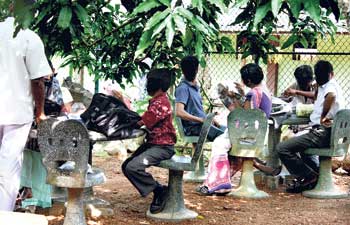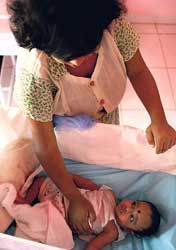Freedom’s in the air
Revolutionary changes at Angoda Hospital have made it a far more patient-friendly institute.
Kumudini Hettiarachchi reports, Pix by M.A. Pushpa Kumara
The moment a person was admitted he was usually given the water treatment -- dunked in a bucket of water, till close to drowning, taken out spluttering and marched to a ward. Assaults were the order of the day. ECTs or shocks to the brain were doled out like common fare.
The women were mandatorily required to strip before bathing and that too in bathrooms sans doors. Some of them were tied up, with ropes or strips of cloth either to their own beds or through permanent holes in the walls of the building.
 |
| Chatting with relatives. |
High walls, locked doors and barred windows. It was a closed, drab, gloomy and depressing world few outsiders could penetrate.
Welcome to the Angoda Mental Hospital under the administration of which also comes Unit 2 of Mulleriyawa. A prison, nay a hell on earth, notorious for acts of inhumanity, with no respite for the unfortunates who were forced in there.
This is a flashback, for all that is history now.
“Paththaren avith mehe nedda yam kenek,Ganna ganna mage rupe mang photogenic.”
Lines of a popular Sinhala song about a “newspaper being there and urging that his photo be taken” is lustily belted out by one person hanging on to a grilled window, while another joins in, adding a proviso: “If it is the Lankadeepa group it is okay because all other papers are pacha paththara (bogus papers).”
The Sunday Times is in the very heart of the Angoda Mental Hospital and what a change……….the walls are painted bright oranges, greens and blues. Fountains play merrily in ponds dotted with lotuses, the garden is manicured and the wards are clean.
Where once it was “secured”, on Monday some patients could be seen talking to relatives seated out in the garden, in a relaxed atmosphere.
The changes have been wrought “rapidly” after Dr. Jayan Mendis took over in 2002 “quite accidentally” as Director, as he himself concedes. Persuasion of the other staff, mostly through discussion but sometimes through tough measures have worked wonders at the hospital.Talking to Dr. Mendis, who has been part of the Angoda Mental Hospital firstly as a “post-intern” way back in 1986 and then on and off and finally as a Consultant Psychiatrist, the issues there have been obvious and once the administrator’s job came to him, the path was clear.
Flicking through a bulging file with clippings on what had been acutely wrong with Angoda including The Sunday Times shocker of a story and photograph of women patients being tied up at Unit 2, Dr. Mendis assures: “The holes in the wall have been closed.”
Recalling how he “accidentally” got the unenviable job of Director, he says when the last one left, the authorities asked senior psychiatrists to take over but all refused. He was the junior-most when it came down the line and though his family was not overly happy, he had a vision for Angoda. System changes were the priority.
Dealing with the assault of patients, Dr. Mendis explains that before 1950 treatment for mental illness was not that developed and assaults were part of the “therapy”. The minor staff also used to forget themselves and get personally involved with the patient. To add to the problems, the assaults were never reported.
“Accidental,” was the excuse given by the staff and in the mornings the doctors were told that the patients had fallen off the beds. On the part of the doctors, they would never ask the patients’ side of the story, he said. “Now both staff and patients know that I am very strict on this issue,” he says, adding that no intentional assault takes place and every injury incident has to be looked into and the patient’s explanation taken.
Listing out the issues which have been causing human rights problems, Dr. Mendis says those days no patient could meet his/her relatives without a staff member peering over their shoulders and listening to the conversations. There was no privacy. Such staff supervision may have been necessitated by concern that patients could harm someone, but now the staff does keep a close eye but does not stand guard. The restrictive visiting hours have also been changed. Earlier relatives could see patients during one hour in the morning and one hour in the evening. Now it is visiting time from 6 a.m.-8 p.m. The prohibition on children visiting a father or a mother has also been lifted.
The system of containing all “restless” patients in one room has been stopped. “As a Medical Officer those days I used to go from ward to ward suturing faces of patients who had had violent fights,” says Dr. Mendis.
Taking us around the hospital, Dr. Chamari Mudalige details the revolutionary developments. “Those days all ‘acute’ patients (with a first episode of mental illness) who were prone to be more restless and ‘long-term’ patients were all put together. Now there are ‘acute and intermediate’ sections for every ward, because if acute patients are restless, the others too could be affected. Patients with a first episode which lasts more than a month are later sent to the intermediate section. Aggression is handled with care and sometimes they are sedated or secluded. The long-term patients who fall into a routine and don’t show any aggression are then channelled into rehabilitation which takes the form of ward-based, occupational or horticultural therapy.”
Admissions are also done differently, with patients not being sent to the wards directly but being kept at the ICU to calm them down. The patients are also not caged in wards. A large area of garden is fenced off and patients are free to walk there, points out Dr. Mudalige, adding that 4% of the population usually has severe mental disorders which require hospitalization.
A stop has also been put to the habit of some of the minor staffers who if they didn’t like the face of a patient or the relatives would find some excuse to send him/her away, The Sunday Times understands. “The staffers would persuade the doctor to discharge the patient, even though he/she required treatment, failing which they would conveniently keep the door open for the patient to walk away,” says the Director, adding that in some extreme cases the patient would even end up at Kanatte.
The practice was also for the minor staff and not the junior doctors to decide which patients would be seen by the senior doctors. Nurses were also powerless and the system was bad, The Sunday Times learns. During the day only one doctor was on duty and during the night too only one. The other doctors would only be around to discharge the patients. There were no rooms to interview the patients. “I have seen patients dead on the floor for more than eight hours with even rigor mortis having set in, with no one removing them,” he says.
| Please help us |
 |
| Dr. Mendis |
The
plans for the future are to set up separate units for those with learning difficulties who develop mental illnesses and an adolescent unit to see to the needs of those between 13 and 18.
Generous donors who are willing to support us are most welcome, Dr. Mendis says appealing for support from the public. |
Commenting on a humane problem, Dr. Mendis says that he used to see female patients clutching their underwear and a few pieces of clothing topped by a packet of Lemon Puff. “They didn’t have any lockers to keep their stuff. There were also no mirrors.”
Night admissions were prolonged because the clerk who handled the paperwork had quarters far from the main hospital. The volume of medications requested for the patients at night was immense, with most of it finding its way to the “handiya around the corner”, says Dr. Mendis.
Only a few of the medical tests on patients could be carried out by the Mental Hospital – (WBC/DC, haemoglobin and ESR) with all the others having to be sent to the National Hospital. Now the blue-painted lab on the Angoda premises does 56 tests, The Sunday Times learns. A physician is also attached to Angoda now to deal with medical problems.
Turning the world within the Mental Hospital upside down, teams of doctors-nurses-minor staff responsible for their own wards and thus accountable have been set up, registers and ‘Incident report forms’ put in place to record all happenings and monthly conferences held to discuss patient deaths. To seclude or restrain patients, special forms have to be filled and justified. Night rounds, hand-over meetings between day and night staff, quarters for staff on duty and foreign training not only for doctors but also for nurses form part of the improvement package. The success of the radical changes can very well be judged by the fact that a drastic drop has been recorded in the number of ECTs administered to patients -- from 150 a day to barely 20 and even those with consent forms being signed not by relatives but by the patients themselves.
Another important aspect that Dr. Mendis has focused on is the Psycho-geriatrics Unit. “From two 10-bed wards for males and females, it has been expanded to 25 beds each,” says Consultant Psychiatrist Dr. Pushpa Ranasinghe, stressing the need as vital as Sri Lanka has an aging population. “Well-equipped taking into consideration their special needs, the unit caters to those above 65 years old who have mental illness,” she says giving the statistic of 30% of those over 90 developing dementia.
Commending the health authorities for being very supportive, Dr. Mendis says the nursing cadre has expanded from 150 to 300 and the medical officer cadre from 30 to 60 doctors. Eight Consultant Psychiatrists head the eight wards.
Support has been forthcoming from organizations such as Indrakeelaya (a group of retired bank employees who had experienced the Central Bank bomb blast), Alzheimers Foundation and the YWCA.
Heading a facility housing more than one thousand patients, Dr. Mendis is also in the process of getting a name-change – from Angoda Hospital synonymous with pissu to the National Institute of Mental Health.
The front wall bordering the road is to be demolished and a wire fence put up for people on both sides of the divide to see what is happening on the other and open days are to be held.
The thrust now is to dispel stigma and give freedom and dignity to those suffering from mental illnesses.
Baby, mother and father: Together at last
Pinks and blues…….the baby colours. That’s what greets the visitor to the eight-bed ‘Mother-and-Baby Unit’ where new mothers who suffer from post-partum depression or psychological problems could recover, keeping their husbands or a close relative at their side.
Usually what happens is if the new mother falls ill, she is brought to Angoda, the baby is separated from her and taken to the Lady Ridgeway Hospital for Children and the distraught husband most probably goes back to his mother, says Dr. Jayan Mendis. But now, rooms with attached bathrooms help the family to stay together, while the new mother recovers in tranquil surroundings.
|



